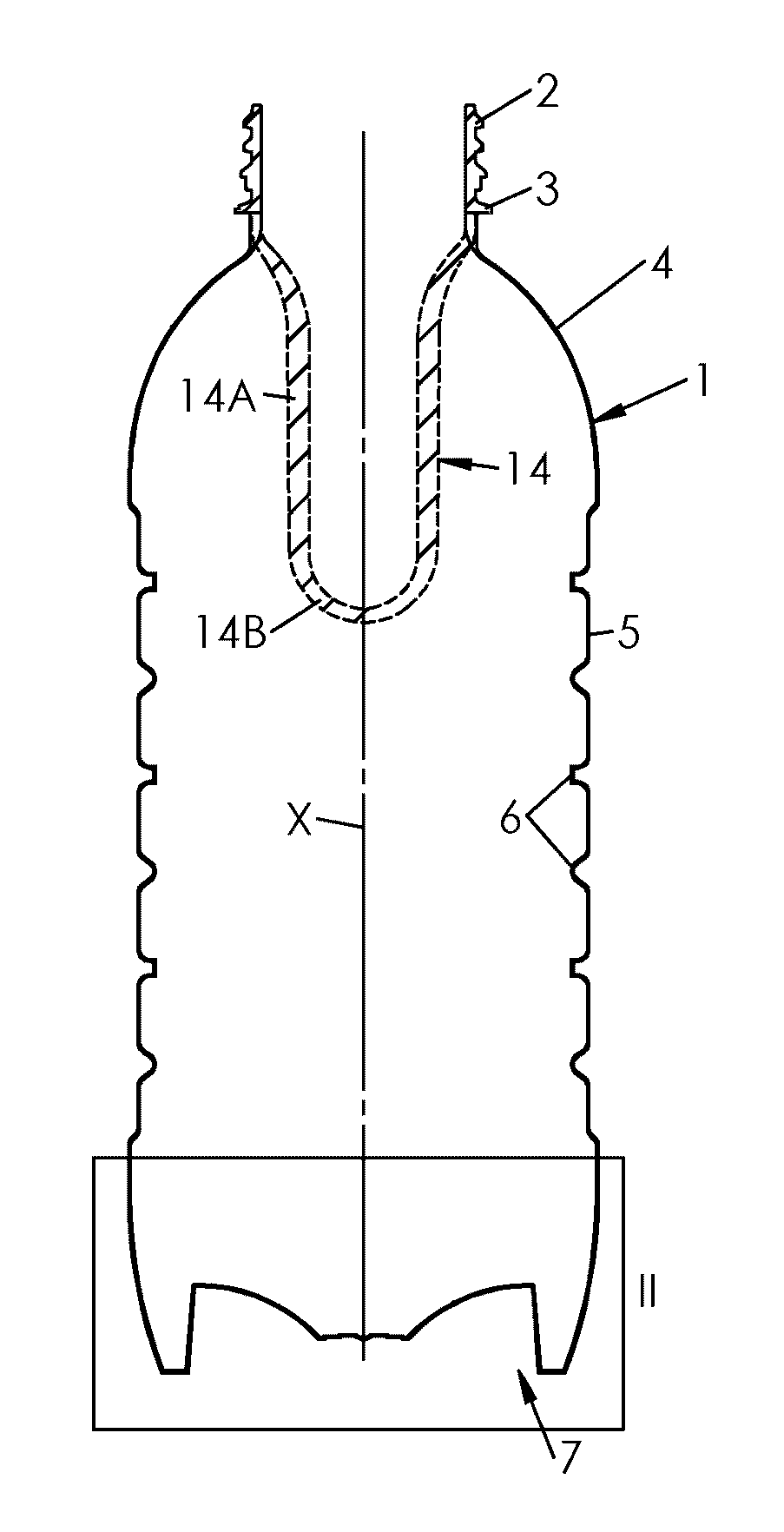Container provided with a curved invertible diaphragm
a technology of invertible diaphragm and container, which is applied in the field of container manufacturing, can solve the problems of bending of containers, reducing the stability of the pressure panel, so as to achieve greater stability
- Summary
- Abstract
- Description
- Claims
- Application Information
AI Technical Summary
Benefits of technology
Problems solved by technology
Method used
Image
Examples
first embodiment
[0046]In a first embodiment illustrated on FIG. 2, the diaphragm 11 has, in the outwardly-inclined position, a radius of curvature—denoted R—which is constant or substantially constant from the outer junction 12 to the inner junction 13.
[0047]In a preferred embodiment, R is of about half the outer diameter D2 of the diaphragm 11:
R≅D22
[0048]In the embodiment depicted on FIG. 2, a tangent of the diaphragm 11 to the outer junction 12 is horizontal, i.e. perpendicular to the main axis X of the container 1, in the outwardly-inclined position.
[0049]During inversion, the tangent maintains its orientation. Therefore, in the inwardly-inclined position, the diaphragm 11 has an outer portion 17, adjacent to the outer junction 12, which is also curved in radial section, but with a concavity turned inwards with respect to the container 1. In FIG. 2, R2 denotes the radius of curvature of the outer portion 17. The inner portion 16 and the outer portion 17 meet at a median junction 18 which, in rad...
second embodiment
[0050]In a second embodiment illustrated on FIG. 3, the radius of curvature of the diaphragm 11 has, in the outwardly-inclined position, at least two values. More specifically, the diaphragm 11 has, in the outwardly-inclined position:[0051]an inner portion 19 which, in radial section, is curved with a concavity turned outwards with respect to the container 1, with a radius of curvature denoted R3, and[0052]an outer portion 20 which, in radial section, is curved with a concavity turned outwards with respect to the container 1, with a radius of curvature denoted R4, smaller than R3:
R4≦R3
[0053]More precisely, R3 and R4 are preferably such that their ratio is comprised between about 0.2 and 1, and more preferably of about 0.30, as depicted on FIG. 3:
0.2≤R3R4≤1
and, preferably:
R3R4≅0.3
[0054]In addition, the inner portion 19 and the outer portion 20 connect at a circular junction 21 having a diameter, denoted D3, such that the ratio of D3 and D2 is comprised between 0.5 and 1, and preferab...
PUM
 Login to View More
Login to View More Abstract
Description
Claims
Application Information
 Login to View More
Login to View More - R&D
- Intellectual Property
- Life Sciences
- Materials
- Tech Scout
- Unparalleled Data Quality
- Higher Quality Content
- 60% Fewer Hallucinations
Browse by: Latest US Patents, China's latest patents, Technical Efficacy Thesaurus, Application Domain, Technology Topic, Popular Technical Reports.
© 2025 PatSnap. All rights reserved.Legal|Privacy policy|Modern Slavery Act Transparency Statement|Sitemap|About US| Contact US: help@patsnap.com



